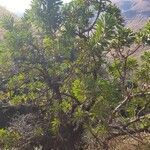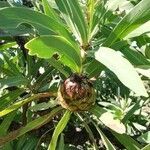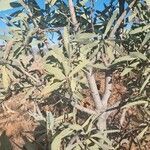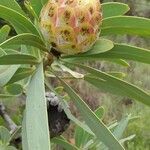Shrub to small tree (0.3-)1-4(-7) m. high.. Young stems ± glabrous, smooth, usually dark brown in the Flora area.. Leaves usually linear-elliptic to linear-oblanceolate, rarely (not in the Flora area) obovate to oblanceolate, (5-)6-17 × (1-)1.3-4(-4.5) cm., (1.5-)4-10 times as long as broad, glabrous.. Heads 6-13 cm. in diameter.. Middle bracts obtuse to rounded, 1.7-3 × (1-)1.2-2 cm., glabrous or densely pubescent when young and rapidly glabrescent, whitish or green to brown or dark red; inner bracts (3.5-)4-8 × 0.5-1 cm., linear-oblong, like middle bracts in colour and indumentum.. Flowers 4-7 cm., white or (in other subspp.) often pink.. Perianth-base glabrous; claw glabrous to villous both inside and outside; limb 10-21 mm., densely villous when young at least at the tip but usually glabrescent.. Style glabrous.
Small tree, erect, single trunk, 3-8 m high, or multi-stemmed, branched shrub, 1-3 m high. Leaves linear-oblanceolate to elliptic, 70-170 x 13-30 mm, glabrous, glaucous, coriaceous, acute or obtuse. Flower head globose to ovoid, 55-70 x 40-70 mm, solitary or clustered. Involucral bracts 6-8-seriate, pink to cream-coloured, imbricate, glabrous to hairy; outer series ovate to triangular, acute, 5-7 x 10-20 mm; inner series oblong to spathulate, rounded, 30-50 x 10-20 mm. Flowers 45-60 mm long, tube 10-14 mm long, hairy or glabrous; style 40-60 mm long, curved; pollen presenter 7-12 mm long, thread-like, bent at base. Flowering time Oct.-Jan.
Middle bracts 1.7–3 × (1)1.2–2 cm, obtuse to rounded, glabrous or densely pubescent when young and rapidly glabrescent, whitish or green to brown or dark red; inner bracts (3.5)4–8 × 0.5–1 cm, linear-oblong, like the middle bracts in colour and indumentum.
Perianth base glabrous; claw glabrous to villous both outside and inside; limb 10–21 mm long, densely villous when young at least at the tip, but usually glabrescent.
Young stems ± glabrous, smooth, usually dark in the more northern subspecies and usually greyish in the southern subspecies.
Leaves (5)6–17 × (1)1.3–4(4.5) cm, (1.5)3–10 times as long as broad, variable in shape (see subspecies), glabrous.
Flowers 4–7 cm long, white or rarely pink.
Shrub to small tree (0.3)1–4(7) m high.
Heads 6–13 cm diameter.
Style glabrous.








